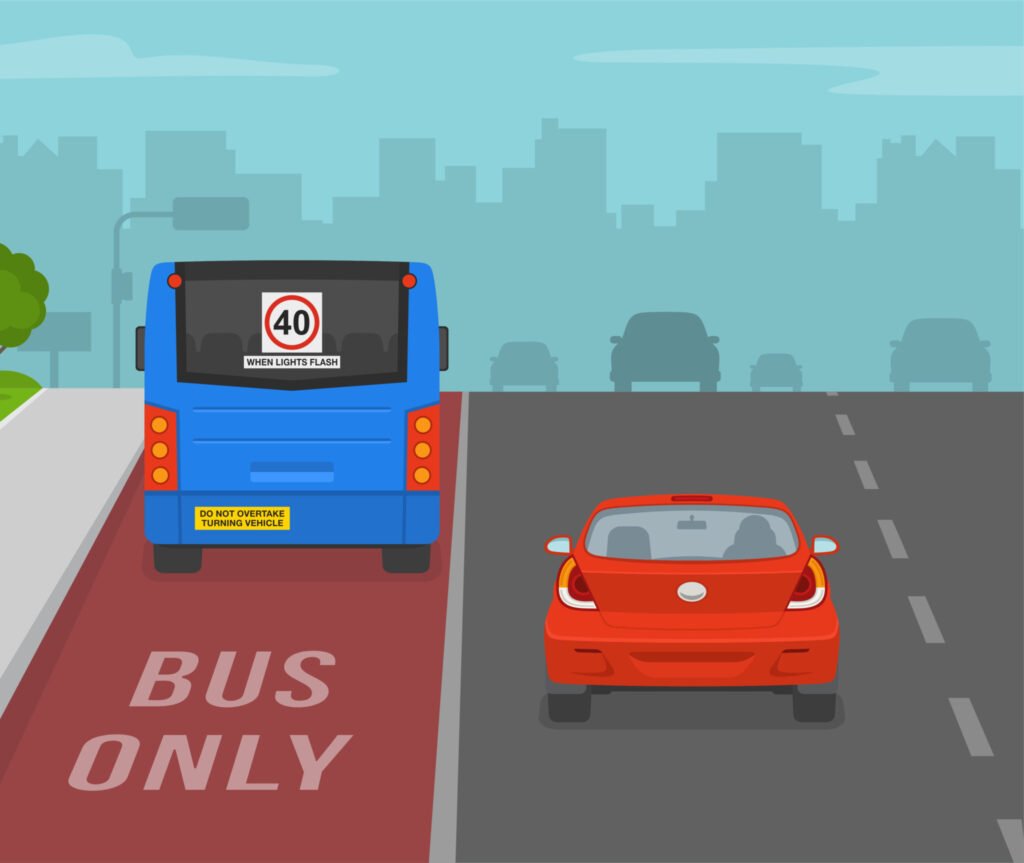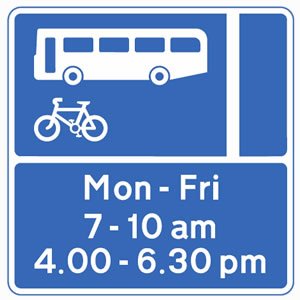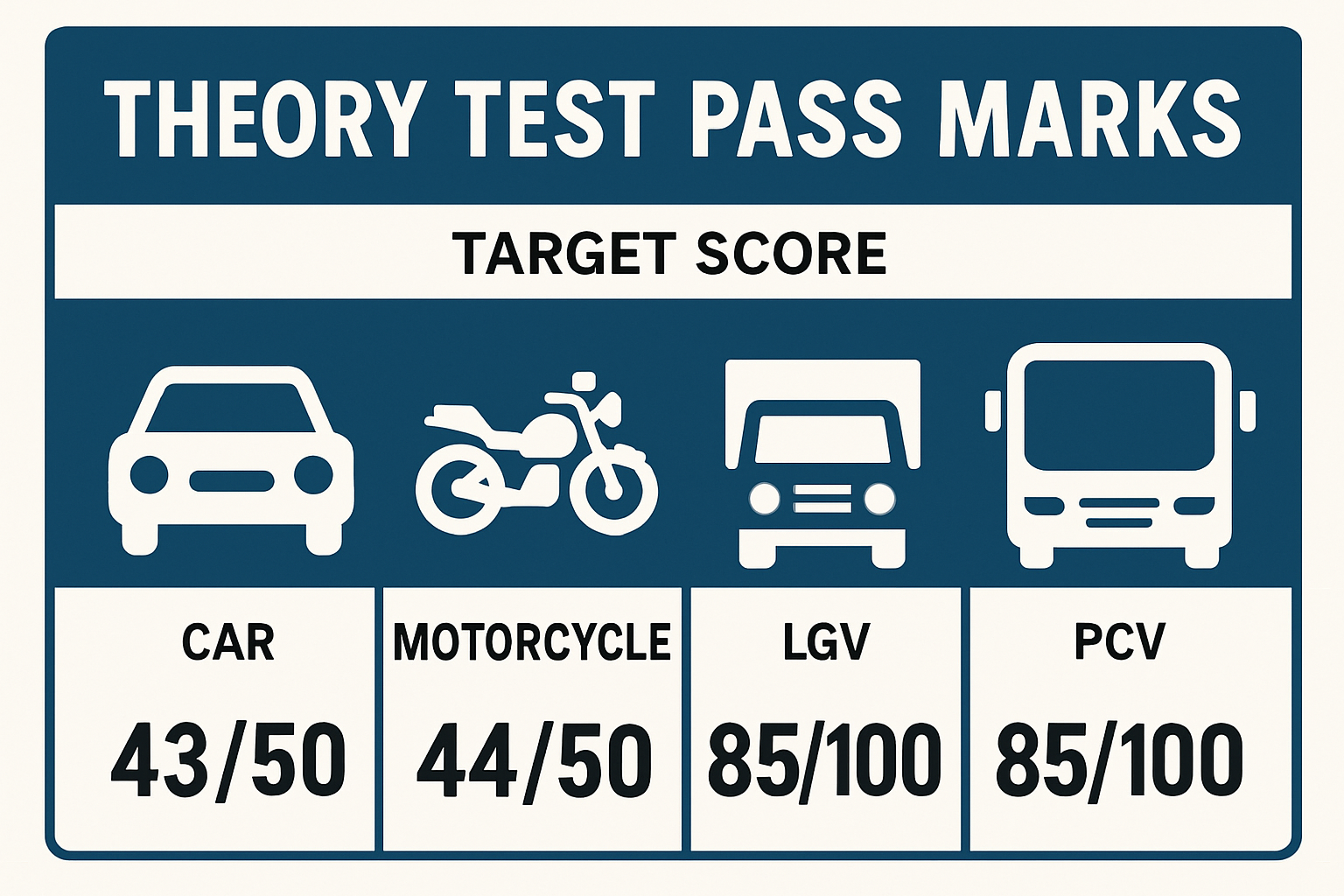Near-Side With-Flow Bus & Cycle Lanes vs Off-Side With-Flow Bus & Cycle Lanes
https://drivertrainingtheory.co.uk/near-side-with-flow-bus-cycle-lanes-vs-off-side-with-flow-bus-cycle-lanes/Near-Side vs Off-Side With-Flow Bus & Cycle Lanes

Bus and cycle lanes are everywhere in Britain’s towns and cities. They’re designed to keep public transport and cyclists moving efficiently, while general traffic queues elsewhere.
Most of us are familiar with the common with-flow bus lane (running in the same direction as traffic), usually tucked neatly down the left-hand side. But every so often, you’ll encounter one that sits on the right-hand side instead. That’s where the terms near-side and off-side come in.
Near-Side With-Flow Bus & Cycle Lane

- Location: On the left-hand side of the carriageway (nearest the kerb).
- Who uses it: Buses, and sometimes cycles or taxis if shown on the sign.
- On the road: This is the most common type you’ll see — a solid white line, a blue bus lane sign, and operating times listed underneath.

- Driver impact: Drivers must not enter the lane during its hours of operation. At junctions, look carefully for buses or cyclists alongside you before turning left.

Theory Test Angle: You could be asked what the sign means, what vehicles can use the lane, or what you must do if turning left across one.
Off-Side With-Flow Bus & Cycle Lane

- Location: On the right-hand side of the carriageway (the “off-side”).
- Who uses it: Again, buses (plus cycles or taxis if shown).
- On the road: Far less common. These appear where the layout makes a left-hand lane impractical, such as in one-way systems or wide multi-lane roads.

- Driver impact: These can feel unusual — you’re driving with a bus lane on your right instead of your left. Overtaking is restricted, and turning right across them needs extra care.
Theory Test Angle: A favourite trick in the test is to show a sign for an off-side with-flow bus lane. Many learners assume “bus lane = near-side” and miss that it’s marked on the off-side. The correct answer often relates to not driving or overtaking in it.
Why the Difference Matters
- In practice: Misjudging which side the bus lane is on could lead to cutting across buses or cyclists, or drifting into a restricted lane.
- In the theory test: Both near-side and off-side lanes use the same blue rectangular sign, but the diagram will show whether the bus lane is to the left or right of general traffic. The examiners want to see if you spot that subtle difference.
Traditional Motoring Wisdom
In the golden days, a bus lane almost always meant “keep out of the kerbside”. But road layouts have evolved, and off-side lanes are part of that change. The principle remains: a competent driver always reads the full sign and markings, not just the headline symbol. Observation and anticipation — the timeless values of good driving — make all the difference.
Quick Comparison
| Lane Type | Where It Runs | Common Use Case | Driver Action |
|---|---|---|---|
| Near-Side With-Flow Bus Lane | Left-hand side | Most common layout | Don’t enter during restricted hours; watch for buses/cycles when turning left |
| Off-Side With-Flow Bus Lane | Right-hand side | One-way systems, multi-lane roads | Don’t enter; take care overtaking or turning right |
What is the basic advice for handling bus lanes while driving?
The key advice is to not enter bus lanes during operational hours, watch for buses and cyclists when turning, and be extra cautious with off-side lanes, especially in special layouts like one-way streets or multi-lane roads.
What should drivers remember about observing bus and cycle lanes?
Drivers should always carefully read full signs and markings to identify whether a bus lane is near-side or off-side, and follow the specific rules for each to ensure safety and avoid penalties.
How can confusing bus lane signs affect drivers during a driving test or in real life?
Confusing signs, especially for off-side lanes, can lead drivers to mistakenly think a bus lane is on the near side, risking cutting across buses or cyclists or drifting into restricted areas, which can be dangerous and might cause faults in the driving test.
Why do off-side bus lanes matter and where are they usually found?
Off-side bus lanes are important because they appear in specific road layouts like one-way systems and wide multi-lane roads, where the left side lane isn’t practical for buses or cycles, and drivers need to be extra careful when overtaking or turning.
What’s the difference between near-side and off-side with-flow bus and cycle lanes?
Near-side bus and cycle lanes are on the left-hand side of the road, used mostly in common layouts, and drivers should avoid entering during operating hours. Off-side lanes are on the right-hand side, less common, and are found on one-way systems or multi-lane roads, requiring extra caution when overtaking or turning right.
Contents
- 1 Near-Side With-Flow Bus & Cycle Lanes vs Off-Side With-Flow Bus & Cycle Lanes
- 1.1 https://drivertrainingtheory.co.uk/near-side-with-flow-bus-cycle-lanes-vs-off-side-with-flow-bus-cycle-lanes/Near-Side vs Off-Side With-Flow Bus & Cycle Lanes
- 1.2 Near-Side With-Flow Bus & Cycle Lane
- 1.3 Off-Side With-Flow Bus & Cycle Lane
- 1.4 Why the Difference Matters
- 1.5 Traditional Motoring Wisdom
- 1.6 Quick Comparison
- 1.6.1 What is the basic advice for handling bus lanes while driving?
- 1.6.2 What should drivers remember about observing bus and cycle lanes?
- 1.6.3 How can confusing bus lane signs affect drivers during a driving test or in real life?
- 1.6.4 Why do off-side bus lanes matter and where are they usually found?
- 1.6.5 What’s the difference between near-side and off-side with-flow bus and cycle lanes?


